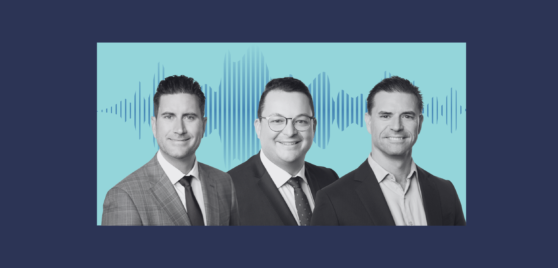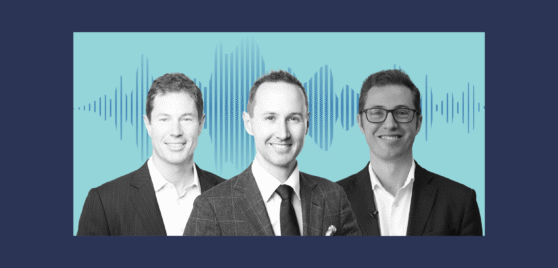Featuring Josh Freiman
LISTEN
READ
Brambles is an Australian global success story and a high-conviction holding in IML’s large-cap portfolios. It has had a very successful year and is up around 35% in 2024, but is it in now fully valued, or is there more to come?
On the Navigating the Noise podcast, IML Equity Analyst Josh Freiman talks Jason Guthrie through his investment thesis for IML’s Stock of the Month, Brambles, and why he forecasts compound annual earnings per share (EPS) growth of more than 10% for the next three years.
Follow our podcast, ‘Navigating the Noise’ on Spotify, Apple or Amazon to be notified of new episodes.
 |
 |
 |
Lightly edited transcript
Podcast recorded on Thursday, 7 November.
Jason Guthrie: Hello and welcome to Navigating the Noise, a podcast by Natixis Investment Managers Australia, where we bring you insights from our global collective of experts to help you make better investment decisions. I’m your host, Jason Guthrie, Head of Wholesale, and today I’m joined by Josh Freiman, one of IML’s equity analysts, to discuss our stock of the month, Brambles. Josh, welcome. Great to have you back on the podcast.
Josh Freiman: Great to be here.
Jason: So we’re here to talk about Brambles. It’s a big holding across a number of IML portfolios despite being a top-50 name company on the ASX, around a $26 billion market cap. I think it operates in around 60 countries. My general observation is that it doesn’t really get as much press as some of the other Aussie success stories. Can you maybe start by talking us through their current business model?
Josh: Sure. So Brambles is a pooled pallet provider, and what that means is they really supply to the retailing and manufacturing industries and FMCG, or fast-moving consumer good, industry. They provide pallets that allow all of those businesses to deliver their products to their own customers. And so they’re an integral part of the economy that’s necessary for all of those businesses to really function.
Jason: Now, the way I understand it, the platform really does form, I guess, this invisible backbone of global supply chains. Can you talk us through what their actual client list looks like? I think they partner with around 300,000 companies, if I’m right.
Josh: You are right. They do have over 300,000 customers. Look, some of their major customers are the kind of multinational global corporations that everybody off the street would know. So we’re talking companies like Costco, companies like Walmart, companies like Coca-Cola, General Mills, Procter & Gamble, Unilever, and even in Australia you’d be thinking of companies like Woolworths as well, and even someone like Driscoll’s Berries. So if you can see a product that you’re trying to buy, there’s a good chance that the manufacturer of said product or the retailer of said product is a customer of Brambles.
Jason: Moving on to your recent trip, I know listening to the recent podcast, you did actually visit the company as part of their investor day, I think it was in Texas. They seem to have done a great job investing particularly in technology, particularly in GPS tracking to reduce pallet losses. Pallet losses are clearly a big thing and a big cost for the business, but also the environment. Can you maybe first explain how they actually lose pallets in the first place?
Josh: Sure, and it’s a good question because historically it’s been a bit of a problem for Brambles, but it’s an area of big improvement for them and is part of our thesis for why the company is attractive. So the way pooled pallets work is you lease those pallets out to the companies and then when they’ve finished distributing them around their network and taken the goods off the pallets, they either drop them back to you or you return and pick them up as Brambles. Now the issue with that is, as Brambles, the owner of the pallets, you’re not in control of the speed of those pallets moving through your client’s network, and you’re also not in control of where those pallets go.
So while the customer has possession of the pallet, it’s their responsibility to move it quickly and in the right direction. Now, the issue with that is some clients that don’t perhaps have the strongest controls on their supply network and supply chain can often end up losing some of those pallets or damaging some of the pallets or even seeing some of those pallets being onsold to people who don’t have the rights to buy them. And that’s how you see those blue CHEP pallets, which is Brambles main brand, end up in pallet recycling yards.
Jason: Hopefully, they’re charging those companies a little bit more, those ones that are losing all their pallets. So what does the actual technology look like and how has it improved things since they’ve started to implement through the pallet business?
Josh: Yeah, it’s a great question, and it’s something that they’re still working on. What I will point to is, given Brambles is a global company and they operate in many, many markets, it’s much easier for them to test and learn in a smaller market. And what they did is they undertook a strategy called serialisation, and they effectively turned the entire pool of pallets in Chile to be serialised, which means they can track them, they know where they are, and they can see those pallets moving in and around the economy and country. Now, what that did is it allowed them to develop analytics to see how pallets move, where they get trapped, and where they get lost, and they’ve been able to take the learnings from Chile and start to deploy them in their other markets.
Now, they haven’t rolled out serialisation to all of the other markets and they haven’t rolled out their next step yet either. They’re continuing to do the business case and the investigations for it and costing out the benefit and the impact. But the idea is they’re eventually going to find a way to serialise the full pallet pool or at least a portion of the pool, and that should make their pooled pallet network far more efficient and should lower the losses on their book and improve the cash flow generation.
Jason: Fantastic. Now, Brambles also ranks quite highly as one of the world’s most sustainable companies, certainly in the logistics space. It really looks to be a clear differentiator versus some of their competition. Can you give us some examples of how they’re leading the charge in sustainability?
Josh: Sure. If we look at pallet providers, there’s two types. There’s pooled, where the pallet company owns the pallets and then rents them out and they’re returned to the pallet provider, which is obviously quite sustainable as the pallets are reused. And then there’s what’s called whitewood pallet providers, and that’s a single use pallet, which the manufacturer or retailer buys off the pallet manufacturer. Now, those pallets are lower quality and usually not built from sustainable wood and so they’re far less sustainable and environmentally friendly than the pooled pallet providers. Now, when you consider Brambles, all of their sources of lumber are strictly sustainable. They don’t source any lumber from unsustainable or protected areas. And as a result, as their product is consistently reused and turns over far more than whitewood pallets and comes from sustainable lumber sources, they’re one of the most sustainable companies in the market. I believe MSCI actually awarded Brambles the maximum AAA rating and ranked them in the top 8% of all companies assessed globally. And when reflecting on our portfolio, it remains one of, if not the best, ESG rated company within our portfolio.
Jason: Thanks, Josh. So maybe just in finishing up, they’ve obviously had really strong financial results. They had a very strong reporting season. Stock’s up around 35% year to date, so pretty good outcome for IML investors, which is great. They’ve also announced a buyback, I think, and increase their dividend payout ratio, which all investors love. So can you maybe touch on some of the key numbers and at these prices, do you think there’s further upside?
Josh: Yeah, great, great question. So when I look at Brambles, it’s probably worth discussing the context in which it was operating in maybe for the past two years or three years or so. So if I reflect on the COVID lockdown periods, during that period, we actually saw significant increased consumer spending. And what that resulted in was, as people continued to purchase more and more while they were stuck at home, there actually became a shortage of pallets. And so Brambles and other pool pallet providers and whitewood pallet providers had to invest significant CapEx (capital expenditure) which reduced free cash flows, to build and source new pallets. Now, as we came to an end of that period, and you saw in 2023 and 2024, we started to have a glut of pallets in the economy and as that occurred Brambles was able to improve their efficiency and dial back on that CapEx spend to build and source new pallets.
And as a result, what we’ve started to see now is we’ve seen the pallets that are in the pooled pallet network move through the economy faster, there’s less holdups and waits and trapped pallets, and there’s less need to spend money to build and source and send out new pallets. And as a result, we’ve seen the cash flow generation and the performance of Brambles really accelerate over the last 12 months. Now, while Brambles has obviously seen rapid share price re-rating and improved operational metrics, I just want to re-articulate that the future looks really bright. When I look at how the business is tracking with that serialisation plan, with the different asset efficiency or pallet retention programs that they have in place, we’ve really started to see their cashflow generation improve. We’ve started to see their margins tick up. And when I look at the business, interestingly, the revenue performance in the first quarter trading update was a little bit weaker than consensus expected.
But when you dialed into the numbers and dug a bit deeper and spoke to management, it was clear that that’s actually a good sign. And the reason for that is it’s because they’re actually doing more dynamic pricing as they’ve been able to track which customers are treating the pallets well and moving them quickly and which aren’t. And so they’re incentivising customers to do better with their pallets and move them quicker, and as a result, they’re getting better margins as they share those benefits with customers and with shareholders. And so if that continues, which we believe it will, we forecast compound annual growth of the EPS (earnings per share) of over 10% for the next three years, and that leads to significant further opportunities for dividend increases and further share buybacks beyond this next period. So very attractive.
Jason: Thanks, Josh. Lastly, look, big news overnight. Trump, he’s back in the White House as of January. How do you think this impacts, if any, the growth of Brambles given they do have significant revenues and business in the U.S.?
Josh: Sure. So look, CHEP Americas, which is Brambles’ U.S. business, it’s about 40% of the market share of pallets in North America as well as that business providing 56% of EBIT (earnings before income and tax) in FY 24. So it’s a very big part of Brambles book. I would say, as well, that given the 40% market share, Brambles is a very integral part of the economy there and it’s very hard to displace. It would be very, very, very difficult to replace 40% of the pallets in the market and so I think they have a very protected industry and space in that market. I think that they can do well out of a Trump government, especially if the market starts to hum along a little bit quicker.
Jason: Safe place to be. Well, thank you, Josh. It’s been great to discuss Brambles today. Certainly, a little bit more exciting name than many give it credit for, and I can see and hear the conviction in the company in its future prospects. So thank you to our listeners. Please keep the feedback coming and tune in again very soon to hear more from our global collective of experts.
Disclaimer
This podcast has been prepared and distributed by Natixis Investment Managers Australia Proprietary Limited, ABN 60 088 786 289, AFSL 246830 and includes information provided by third parties, including Investors Mutual Limited (“IML”) AFSL 229988, the responsible entity and investment manager for the IML Funds.
Although Natixis Investment Managers Australia believes that the material in this podcast is correct, no warranty of accuracy, reliability, or completeness is given, including for information provided by third parties except for liability under statute which cannot be excluded. This material is not personal advice. The material is for general information only and does not take into account your personal objectives, financial situation or needs. You should consider and consult with your professional advisor whether the information is suitable for your circumstances. The opinions expressed in the materials are those are the speakers and may not necessarily be those of Natixis Investment Managers Australia or its affiliate investment managers. Before deciding to acquire or continue to hold an investment in a fund, you should consider the information contained in the product disclosure statement in conjunction with the target market determination, TMD, available at www.stg-imlimited-staging.kinsta.cloud.
Past investment performance is not a reliable indicator of future investment performance and no guarantee of performance, return of capital, or a particular rate of return is provided. Any mention of specific company names, securities or asset classes is strictly for informational purposes only and should not be taken as a recommendation to buy, hold, or sell. Any commentary about specific securities is within the context of the investment strategy for the given portfolio. The material may not be reproduced, distributed, or published in whole or in part without the prior written consent of Natixis Investment Managers Australia. Copyright 2024 Natixis investment Managers Australia. All rights reserved.
INVESTMENT INSIGHTS & PERFORMANCE UPDATES
Subscribe to receive IML’s regular performance updates, invitations to webinars as well as regular insights from IML’s investment team, featured in the Natixis Investment Managers Expert Collective newsletter.
IML marketing in Australia is distributed by Natixis Investment Managers, a related entity. Your subscriber details are being collected by Natixis Investment Managers Australia, on behalf of IML. Please refer to our Privacy Policy. Natixis Investment Managers Australia Pty Limited (ABN 60 088 786 289) (AFSL No. 246830) is authorised to provide financial services to wholesale clients and to provide only general financial product advice to retail clients.






